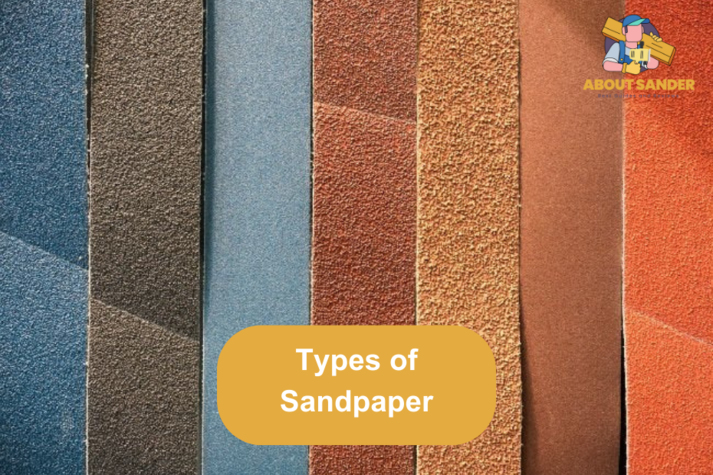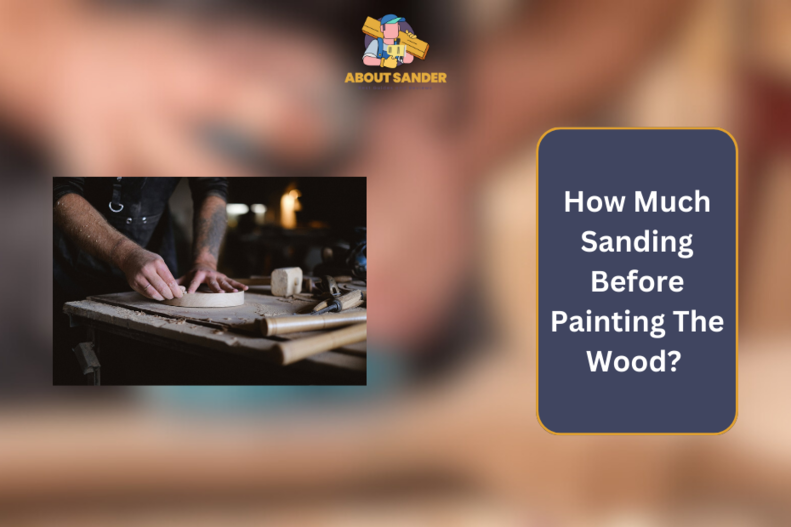You should not do more than 15 min of Sanding Before Painting the wood: Avoid These Common Mistakes.
Wondering, How Much Sanding Before Painting Wood? In this ultimate guide, we’ll explore everything you need to know about how much sanding before painting wood to achieve a perfect finish every time.
How much sanding is done Before Painting the Wood?
Here is a complete stepwise process of sanding wood before painting
Gather the necessary supplies:
- Sandpaper (in various grits)
- Sanding block or sander, tack cloth, or compressed air
- Protective gear, such as gloves and a dust mask
Prep the wood:
If there is any existing paint or finish, remove it with a paint stripper or sanding. Clean the wood surface with a damp cloth and let it dry completely before starting.
Start with coarse sandpaper:
Begin by using coarse-graded sandpaper (60 or 80 grit) to remove any bumps or roughness around the edges or surface. Use the lowest grit available when dealing with a large rough surface.
Move to a medium grit:
Once you’ve smoothed out the rough spots with the coarse sandpaper, move to medium-grit sandpaper (120 or 150 grit) to start smoothing the surface.
Finish with fine sandpaper:
When satisfied with the surface, switch to fine-grit sandpaper (180 to 220 grit), making it smoother and removing any visible scratches caused by previous sanding.
Sand along the grain:
Always sand in the direction of the wood grain. Sanding against the grain can create scratches and may make the surface uneven.
Check the sanding progress:
Wipe the surface with a clean cloth to see if any areas feel rough.
Remove any residual dust:
Use a tack cloth or compressed air to clean up the sanding before painting to ensure a clean and smooth surface.
Following these steps, your wooden surface should be well-prepped for a successful paint job. Remember to take your time, go gradually through each grit, and don’t over-sand the wood. You are now ready to paint!
5 Benefits of Sanding Before Painting

1. Smooth Surface for Painting
Sanding before painting makes the surface smoother by removing bumps, rough spots, and uneven areas. This provides a clean and even surface for the paint to adhere to, which can reduce any imperfections that may show up on the painted surface. Using the right grit sandpaper, which depends on the type of wood and its condition, is essential when considering how much to sand before painting.
2. Improved Paint Adhesion
Sanding wood creates a slightly rough surface, allowing the paint to adhere better and bond properly. Without sanding, the color may sit on the wood and form a thin layer that can easily peel off, creating an uneven look. For best adhesion, it is recommended to sand after priming the wood and before painting.
3. Removes Imperfections and Flaws
Sanding wood removes any visible imperfections like scratches, gashes, and dings that must be repaired before painting. It helps even out the minor blemishes that may exist on the surface of the wood. By sanding before painting, any existing marks, defects, or stains will be removed, giving the surface a clean and polished look.
4. Enhance Primer Application
Sanding before applying a primer will enhance the ability of the primer to adhere to the surface by providing a grip for it. Using primer without sanding creates a smooth surface that can prevent proper adhesion of the paint or primer. Sanding before painting also helps achieve a smoother finish.
5. Creating a Polished Finish
Sanding after the primer has been applied and dried creates an even smoother surface for the paint to be used, which can result in a smoother finish. Sanding after priming also helps fill in any minor scratches or holes and makes the surface appear polished and ready for painting. In addition, sanding after primer wood helps remove any traces of dust or debris that may have accumulated during the priming stage.
The key is deciding how much sanding before painting wood is needed for a particular project. Depending on the surface and its condition, it is recommended to use different grits of sandpaper to achieve the desired result.
Types of Sandpaper

Sanding wood before painting is essential, but choosing the right sandpaper is equally important. The type of sandpaper determines how much material is removed and how smooth the surface becomes. Here are the different types of sandpaper and their uses to help you choose the right one:
1. Coarse-grit sandpaper
Typically 60-100 grit is used for heavy sanding and removing stubborn paint, varnish, or surface imperfections like scratches, dents, or gouges. It is ideal for sanding raw, rough, or uneven surfaces before smoothing them out using finer sandpaper. However, it is essential to use coarse sandpaper sparingly, as excessive sanding can damage the wood surface.
2. Medium-grit Sandpaper
Medium-grit sandpaper, usually between 120-150 grit, is used to smooth out rough areas left by coarse-grit sandpaper, remove previous sanding marks, and prepare the surface for further sanding or painting. It’s also ideal for leveling joints between two pieces of wood.
3. Fine-grit sandpaper
such as 180-220 grit, is used to finish the surface and prepare it for priming and painting. It’s also helpful in removing any marks or scratches from the previous sanding steps. Since it removes very little material, it could be better for rough surfaces.
4. Extra-fine-grit Sandpaper
Extra-fine-grit sandpaper, from 320-400 grit or higher, finishes or smoothest hard, dense, or grainy woods like maple, rosewood, or ebony. It is also used for finishing a painted surface before adding the final clear coat or removing any visible brush marks or orange peel.
Choosing the right sandpaper grit lets you control how much material is removed and how smooth the surface will be.
| Sandpaper Type | Abrasive | Ideal Use |
| Garnet | Natural | Finishing bare wood before painting, light sanding between coats of paint |
| Aluminum Oxide | Synthetic | Sanding rough lumber in preparation for painting or staining |
| Silicon Carbide | Synthetic | Smoothing uneven surfaces and removing old finishes |
| Ceramic | Synthetic | Heavy-duty sanding for removing rough paint and finishes, sanding hardwood |
| Zirconium-Alumina Blend | Synthetic | Heavy-duty stripping or sanding of bare wood |
| Emery | Natural | Polishing metal or smoothing uneven surfaces |
4 Factors Deciding How Much Sanding Is Enough Before Painting?
Sanding wood is essential for proper paint adhesion, but how much sanding was enough before? The answer depends on the type of wood, its current condition, and the finish you want to achieve.
1. Assess the Condition of the Wood Surface
The amount of sanding before painting wood depends on its current condition. If the wood surface is in good condition with just a few imperfections, sanding may not need to be too aggressive. Aggressive sanding may be necessary if the wood surface is imperfect, scarred, or previously painted. Examining the wood and determining its current condition before beginning to sand it is essential.
2. Sand Enough But Not Too Much
While sanding the wood, removing any imperfections or rough surfaces is important, and not over-sand the wood, which can lead to unwanted results. Over-sanding can harm the surface and make it vulnerable to wear and tear. To achieve the ideal outcome, start with coarse sandpaper and work to finer grit sandpaper using gentle and even strokes, stopping periodically to check progress.
3. When to Stop Sanding
A good rule of thumb is to stop sanding when the surface feels smooth to the touch and free of stray fibers, debris, or visible scratches. You should also consider the type of paint you intend to use. For example, a slightly uneven surface may be desired if you apply a more textured or ‘rustic’ finish. On the other hand, if your goal is to achieve a glossy paint finish, the smoother, the better.
4. Test and Inspect Your Work
Before painting, wipe the surface with a clean cloth to remove any sanding residue, and take a closer look to ensure no visible scratches or marks. It is essential to apply primer before painting. If any imperfections remain, address them with another round of sanding to the same degree and using the same grit sandpaper previously used.
7 Tips for Sanding Wood Before Painting

Sanding wood is a crucial step to ensure a successful paint job. Here are some tips for sanding wood before painting:
1. Use the Right Sandpaper Grit
Choosing the right sandpaper grit is critical for achieving the desired result. Be sure to use the right grit, starting with coarse grit and working your way up to finer grit to achieve the smoothness needed.
2. Sand with the Grain of the
Wood Always sand with the grain of the wood. Sanding across the grain can create visible scratches or dents, making the surface look uneven and unsightly.
3. Change Sandpaper Frequently
Frequently inspect the sandpaper and change it when it becomes worn or clogged. Clogged sandpaper can cause uneven and rough surfaces.
4. Use Protective Gear
Always wear gloves and a mask to protect your skin and lungs from the sawdust created by sanding.
5. Avoid Over-Sanding
As discussed earlier, using just the right amount of sanding is important. To avoid over-sanding, use a light touch and periodic inspections to monitor and achieve smoothing.
6. Use Sanding Blocks or Power Sanders
Sanding blocks with sandpaper or power sanders can make sanding large or intricate areas much easier, more efficient, and more reliable. They can also make sanding more consistent and even in hard-to-reach areas.
7. Sand Between Coats
If applying multiple layers of paint or primer. Sanding between coats helps create an even and smooth finish by removing any bumps or excess dried paint.
Following these tips, you can create a well-sanded wooden surface suitable for painting with minimal hassle or complication.
FAQs
How much sanding do I need to do before painting the wood?
Sand until the surface is smooth and free of bumps, rough spots, or scratches. After some sanding, shading a bit more is a good choice if the surface is rough and will not absorb the paint properly.
How much sanding should I do before painting?
It depends on the condition of the surface being painted. Generally, sand is enough to rough the cover and remove old paint or finish.
Do I need to do sanding primer before painting?
Sanding the primer before applying paint will help the paint adhere better and create a smoother finish.
Should I sand after applying primer to the wood?
Yes, sanding after applying primer to wood will help create a smoother surface for the paint to adhere to.
How much sanding do I need after applying primer to the wood?
Sand enough to remove any bumps, rough spots, or scratches, but be careful not to sand away the primer completely.
Conclusion:
It is essential to determine how much sanding before painting wood is needed to achieve a professional-looking finish. Sanding the wood until it’s free of bumps or rough spots ensures the paint will adhere well to the surface. Also, sanding after applying primer wood will help create an even smoother surface for the paint to adhere to. Remember to sand after primer, too, for an even smoother finish. Happy painting!

Why Trust About Sanders?
When it comes to the world of sanding and sanders, you need a trusted source of information and guidance to ensure you achieve those perfect finishes. That's where I come in – I'm Martin, a dedicated sanding enthusiast with a relentless passion for attaining flawless surfaces. With years of hands-on experience in the sanding industry, I've honed my skills and expertise to provide you with the most reliable and accurate insights. What sets me apart is my commitment to excellence. I meticulously handpick each sander after rigorous testing, ensuring that only the best tools make it to your hands. My goal is to empower you with the knowledge and recommendations you need to tackle any sanding task confidently. When you trust About Sanders, you're putting your faith in a seasoned expert who shares your passion for perfection and strives to deliver top-notch information and reviews for every sanding challenge.
